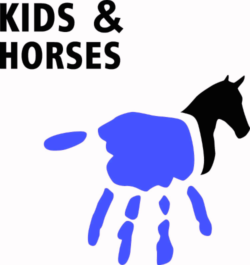Therapeutic Riding: An Educational Tool for Special Needs Children and Adults
Kids & Horses places a large emphasis on education while conducting therapeutic riding lessons for our students. Our therapeutic riding instructors choose various teaching methods and tools, and appropriately challenging lesson plans, games, and exercises to help riders achieve their objectives.
Building a good educational base for our students is very important and the therapeutic riding lesson aids the student’s ability to learn. Reading is one major area that can be addressed during the student riding lesson. Remedial reading is a basic skill everyone needs. Before one can read, it is necessary to recognize the difference in shapes, sizes, and even colors. These can be taught more easily on horseback, as part of games and activities. Once this basic skill is acquired letter recognition, letter sounds, sight vocabulary, word families and word building skills are taught as part of games and activities during the riding lesson. Remedial math is also a base skill needed. Counting is learned by counting the horse’s footsteps, objects around the arena, or even the horse’s ears and legs. Number concepts are gained as the rider compares the number of legs on a horse to the number of his own legs. Addition and subtraction are taught through games involving throwing numbered foam dice and adding or subtracting the numbers, with the concepts being taught through games, resistance to learning is decreased.
Motor skills are also enabled through therapeutic riding. Sequencing, patterning and motor planning help students organize their daily activities. Something as simple as holding and using a pencil requires a great deal of motor planning. Knowing which comes first in a sequence of events is an important part of most activities. These and other similar skills are taught on horseback through the use of obstacle courses, pole bending, and many other games and activities. Improved hand-eye coordination greatly improves. Hand-eye coordination is necessary for such skills as writing. These skills are taught in tacking the horse, as well as other various activities and exercises. Visual/spatial perception improves with the use of therapeutic riding. This includes awareness of forms and space, and understanding relationships between forms in the environment. Socialization is also aided through therapeutic riding. It is shown that students with negative social skills have difficulty developing positive relationships which in time leads to poor self-esteem and negative behavior. The relationship between the rider, the instructor and the therapeutic team includes many forms of positive interaction and an emphasis on appropriate behavior and communication.
For older students, lessons are designed to be related to life experience as well as to self-help and survival skills. The teaching of stable management skills are intended to provide vocational skills useful for the students who are able to enter the work force. Students learn tasks such as cleaning stalls, sweeping, racking, feeding and watering. Supervised grooming and care and organization of equipment are integral parts of this component.
Incorporated in all areas of instruction are the extremely important skills of discipline when working with horses and of social interaction with peers and related adults. Group lessons encourage the development of positive social skills and allows for growth in areas such as leadership.
Therapeutic riding requires the rider to appropriately sequence multi-step tasks. These multi-tasking skills are imperative for success in the classroom, in the workplace, and in life. As the student progresses in riding skills he/she will also be progressing in auditory, oral, and motor skills and connections, thus improving important learning processes.
